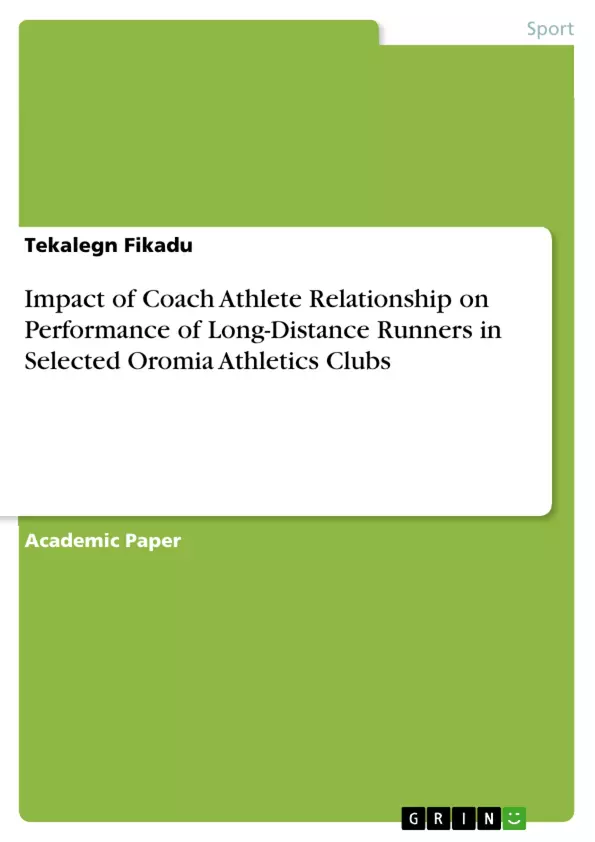The purpose of this study was to assess the impact of coach-athlete relationships on long-distance runners' athlete performance in selected Oromia Athletics clubs. Triangulation design Cross-sectional study design was employed. The population of the study was selected from four clubs. From four clubs 108 athletes’ long-distance events and 17 coaches were totally selected by availability sampling technique. The instrument of data collection used for this study was standard questionnaires and semi-structured interviews. SPSS version 23 was used for the statistical analysis of the data. Descriptive statistics such as percent, and frequency for the demography of athletes and coaches while mean, standard deviation, skewness, and kurtosis were used to analyze the current performance of athletes. Inferential statistics Whereas, linear regression was used to analyze the impact of the 3Cs of coach athlete’s relationship on athlete performance. The average performance of the four club’s female athletes is 32.6944 minutes, the dispersion from the mean is 1.01937, it is (-.117) negatively skewed, and the kurtosis is 0.250, which indicates a distribution that is too flat. The average time of male athletes is 29.72 minutes. SD dispersion from the mean is 1.30705 with skewness of 1.460; and Kurtosis is 3.169, (distribution of mesokurtic).
Inhaltsverzeichnis (Table of Contents)
- CHAPTER ONE
- INTRODUCTION
- 1.1 Background of the Study
- 1.2 Statement of the problem
- 1.3. Research questions
- 1.4. Objectives of the study
- 1.4.1 General Objective
- 1.4.2 Specific objectives
- 1.5 Significance of the Study
- 1.6 Delimitation of the Study
- 1.7. Limitations of the study
- 1.8 Operational Definition of Term
- CHAPTER TWO
- LITERATURE REVIEW
- 2.1 Concepts of Athletics
- 2.1.1 Concept of Long-Distance Events
- 2.2 The Concept of Coach Athlete Relationship
- 2.3 Long-Distance Coach-Athlete Relationship and Performance
- 2.4 A Philosophy for Coaching the Distance Events
- 2.5 Importance of the Good Coach-Athlete Relationship
- 2.6 Factors affecting performance of long-distance runner
- 2.6 Successful versus unsuccessful relationships
- 2.7 Successful athletic performance
- 2.7.1 Factors contributing to successful athletic performance:
- 2.8 Developing an Effective Coach Athlete Relationship
- 2.9 Effective Coaching
- 2.10 The way of developing coach athlete relationship
- 2.11 The3 Cs key constructs used to examine coach-athlete relationship
- 2.12 Conceptual Framework of the Study
- CHAPTER THREE
- RESEARCH METHODOLOGY AND PROCEDURE OF THE STUDY
- 3.1. Description of the Study area
- 3.4. Source of Data
- 3.5. Data Collection of Instrument
- 3.5.1. Questionnaire
- 3.5.2. Interview
- 3.6 Procedure of data collection
- 3.7. Selection of Variables
- 3.8 Method of data analysis and interpretation
- 3.9. Ethical Considerations
- CHAPTER FOUR
- RESULTS AND DISCUSSION
- 4.1 Result Analyzed
- 4.1.1 Athlete and Coach Demography
- 4.1.2 Results compiled from Athletes regarding with CART questionnaires
- 4.1.2.1 Athlete Performance on 10000m of female and male athletes of selected clubs
- 4.1.2.2 Coach Athlete Closeness relationship versus athlete performance related linear regression analysis For Female Athletes
- 4.1.2.3 Commitment of coach athlete relationships versus athlete performance results For Female Athletes (Regression analysis)
- 4.1.2.4Complementarities of coach athlete (Female) relationships versus athlete performance results (Regression analysis)
- 4.1.2.5 Coach Athlete Closeness versus Male Athlete Performance Regression Analysis
- 4.1.2.6 Commitment versus Male Athlete Performance Regression Analysis
- 4.1.2.7 Complementarities versus Male Athlete Performance Regression Analysis
- 4.1.2.8 Conclusion of coach athlete relationship impact on performance of female and male athlete
- 4.2 Discussion
- CHAPTER FIVE
- 5. Summary, Conclusions and Recommendations
- 5.1 Summary
- 5.2. Conclusion
- 5.3. Recommendation
Zielsetzung und Themenschwerpunkte (Objectives and Key Themes)
This thesis investigates the impact of the coach-athlete relationship on the performance of long-distance runners in selected Oromia athletics clubs in Ethiopia. The study aims to explore the relationship between various aspects of the coach-athlete relationship, such as closeness, commitment, and complementarities, and the performance of athletes.
- The impact of coach-athlete relationship on long-distance runners' performance
- Factors influencing the effectiveness of the coach-athlete relationship
- The role of communication, trust, and support in the coach-athlete relationship
- The influence of different coaching styles on athlete performance
- The application of research findings to improve coaching practices and athlete development
Zusammenfassung der Kapitel (Chapter Summaries)
Chapter One provides an introduction to the study, outlining the background, statement of the problem, research questions, objectives, significance, delimitation, limitations, and operational definitions. It establishes the context and rationale for the research. Chapter Two presents a comprehensive review of the relevant literature on athletics, long-distance running, coach-athlete relationship, and factors affecting performance. It discusses the theoretical frameworks and concepts underpinning the study. Chapter Three outlines the research methodology and procedure, including the study area, data collection methods, instruments, selection of variables, and data analysis techniques.
Schlüsselwörter (Keywords)
The key terms and concepts explored in this thesis include coach-athlete relationship, long-distance running performance, athlete performance, coaching styles, communication, trust, support, closeness, commitment, complementarities, and regression analysis. The study delves into the impact of various aspects of the coach-athlete relationship on the performance of long-distance runners. It aims to identify specific factors within the coach-athlete dynamic that influence athletic success.
- Quote paper
- Tekalegn Fikadu (Author), 2021, Impact of Coach Athlete Relationship on Performance of Long-Distance Runners in Selected Oromia Athletics Clubs, Munich, GRIN Verlag, https://www.grin.com/document/1334559



